|
|
 |
Fiche d'espèce de Copépode |
|
|
Calanoida ( Ordre ) |
|
|
|
Diaptomoidea ( Superfamille ) |
|
|
|
Pontellidae ( Famille ) |
|
|
|
Pontellopsis ( Genre ) |
|
|
| |
Pontellopsis lubbocki (Giesbrecht, 1889) (F,M) | |
| | | | | | | Syn.: | Monops lubbockii Giesbrecht,1889; 1892 (p.487, 496, 773, figs.F,M) | | | | Ref.: | | | Giesbrecht & Schmeil, 1898 (p.148, Rem. F,M); Sewell, 1948 (p.392); C.B. Wilson, 1950 (p.310, figs.F,M, Rem.); Silas & Pillai, 1973 (1976) (p.777); Pillai, 1977 (1982) (p.64, figs.F,M, Rem.F); Suarez-Morales & Kozak, 2012 (p.3, Redescr.F, M, figs.F,M, Rem.) | 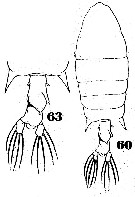 Issued from : W. Giesbrecht in Systematik und Faunistik der Pelagischen Copepoden des Golfes von Neapel und der angrenzenden Meeres-Abschnitte. – Fauna Flora Golf. Neapel, 1892. Atlas von 54 Tafeln. [Taf.41, Figs.60, 63]. As Monops lubbocki. Female: 60, habitus (dorsal); 63, Th5 and urosome (dorsal).
|
 Issued from : W. Giesbrecht in Systematik und Faunistik der Pelagischen Copepoden des Golfes von Neapel und der angrenzenden Meeres-Abschnitte. – Fauna Flora Golf. Neapel, 1892. Atlas von 54 Tafeln. [Taf.26, Fig.18]. As Monops lubbocki. Female : 18, P5 (posterior view).
|
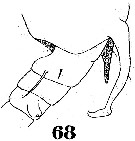 Issued from : W. Giesbrecht in Systematik und Faunistik der Pelagischen Copepoden des Golfes von Neapel und der angrenzenden Meeres-Abschnitte. – Fauna Flora Golf. Neapel, 1892. Atlas von 54 Tafeln. [Taf.41, Fig.68]. As Monops lubbocki. Male: Th5 and urosome (lateral right side)
|
 Issued from : W. Giesbrecht in Systematik und Faunistik der Pelagischen Copepoden des Golfes von Neapel und der angrenzenden Meeres-Abschnitte. – Fauna Flora Golf. Neapel, 1892. Atlas von 54 Tafeln. [Taf.26, Fig.32]. As Monops lubbocki. Male: 32, P5 (posterior view).
|
 issued from : P.P. Pillai in J. mar. biol. Ass. India, 1977 (1982), 19 (1-2). [p.62, Fig.2, c]. Female: c, habitus (dorsal).
|
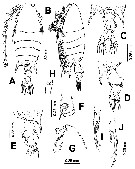 Issued from : E. Suarez-Morales & E. Kozak in ZooKeys, 2012, 234. [p.4, Fig.1]. Female (from off the central Mexican Pacific coast): A-B, habitus (dorsal a nd lateral, respectively); C, urosome showing details of dorsal processes of genital double-somite (ventral); D, ame (left lateral); ; E, same (right lateral); F, genital double-somite (ventral); G, cephalic section (lateral); H, rostrum (ventral view); ; I, right P5; J, left P5. Nota: Cephalon and pediger 1 separate, 4th and 5th fused. Rostrum bifid, with long, slender rostral filaments, gap between rostral rami wide. Urosome 2-segmented. Genital double-somite (representing about 55 % of urosome length, excluding caudal rami), strongly asymmetrical, with pair of dorsal protuberances arising from distal margin of somite; in dorsal view, right protuberance subtriangular, curved, posteriorly directed, reaching about half way along anal somite; left process smaller, also posteriorly directed rounded tapering distally into strongly chitinized bulb-like process. Proximal margin of somite bearing lateral spine-like process on each margin, slightly asymmetrical, right one being longer. Ventral surface of genital-double-somite swollen, with sickle-shaped process ariing anterior to genital operculum, posteriorly directed (Fig.1 D, E, F). Anal somite subrectangular, about1.5 times wider than long, with rounded distomedial process between insertion points of caudal rami; dorsal surface of anal somite swollen in lateral view, ornamented with rows of minute spinules. Caudal rami weakly asymmetrical, left ramus slightly larger than right, both rami bearing 6 setae (1 inner, 3 terminal, 1 outer plus short, slender dorsal seta).
|
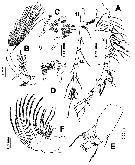 Issued from : E. Suarez-Morales & E. Kozak in ZooKeys, 2012, 234. [p.6, Fig.2]. Female: A, A1 (in two sections); B, A2; C, Md edge showing dentition, apical (a), subapical (sa), medial (med), and basal (bas) teeth; D, same (another view); E, Md (mandibular palp); F, Mx2. Nota: A1 symmetrical, 16-segmented (ancestral segments determined by number of setae, spine and aesthetasc: I-III, IV-VII, VIII-X, XI-XIII, XIV, XVI, XVII, XVIII, XIX, XX, XXI, XXII, XXIII, XXIV, XXV, XXVI-XXVIII). Md with wide, heavily chitinized gnathobase. Mandibular palp biramous, basipod robust, subrectangular, armed with inner seta; Endopod 2-segmented, 1st segment with 3 long and 1 short setae, 2nd segment with 6 terminal setae. Exopod 5-segmented (setal formula 1, 1, 1, 1, 2). Mandibular distal edge bearing 7 teeth: from ventral margin dentition includes 1 apical (a), 1 subapical (sa), 2 compound medial (med), and 3 basal (bas); medial teeth with rounded edges; clusters of long and short spinules on base of medial teeth; dorsal end of gnathobase with tight row of setae. Mx2uniramous, 1st praecoxal endite bearing 4 setae, 2nd with 3 setae (1 of them shorter and thinner than the others); 2 coxal endites each bearing3 setae; basis with 2 setae; endopod 4-segmented (setal formula 2, 21, 1, 1), basal and endopodal setae strongly serrated.
|
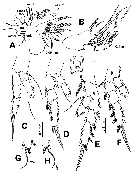 Issued from : E. Suarez-Morales & E. Kozak in ZooKeys, 2012, 234. [p.8, Fig.3]. Female: A, Mx1 showing armature of coxal endite (cx end, distal spiniform elements cut short), proximal basal endite (brnd1), distal basal endite (bend2), epipodite (epi), exopod (exp), and endopod (end); B, Mxp; C, P1; D, P2; E, P3; F, P4; G, variant form of P3 third exopodal segment with flexible terminal setal element (arrowed); H, same, P4. Nota: Mx1 typical of Pöntellids. Praecoxal arthrite with 14 setal elements; coxal endite (cx end) with 3 long, robust spine-like elements on endite and 9 setae onepipodite (epi); basis with 3 and 1 setae on proximal (bend1) and distal (bend2) endites, respectively; 1st and 2nd endopod segments, each with 2 setae, incorporated into basis, distal endopod segment with 5 apical setae; exopod with 8 setae. Mxp: uniramous, with praecoxa and coxa fused, 3 syncoxal endites well developed (setal formula 2, 2, 3); endites setae strong, serrate. Inner lateral margin of 3rd endite with rows of short setae. Basis fringed with medial row of 5-6 spinules and 2 distal setae. Endopod 4-segmented (setal formula 2, 1, 1,2).
|
 Issued from : E. Suarez-Morales & E. Kozak in ZooKeys, 2012, 234. [p.10, Fig.4]. Male (from off the central Mexican Pacific coast): A, habitus (dorsal); B, urosome (vental); C, same (dorsal); D, detail of process on right margin of third urosomite; E, geniculate A1; F, detail of ornamentation on antennular segments 9 and 10 (arrowed); G, detail of ornamentation of proximal part of antennular segment 11 (arrowed). Nota: Cephalosome about 3.5 times as long as urosome (caudal rami excluded), dorsal surface of cephalosome pilose, particularly pedigerous somites 1-5. Urosome with 5 somites. Genital double-somite strongly asymmetrical, left side with 2 sensilla on outer distal corner; right side expanded forming rounded process armed with 2 unequal setae. 2nd urosomite with pair of sensillae on right side. 3rd urosomite as long as succeding somite, with strong laterally-directed rod-like process on right margin, process armed with anterodistal curved row of teeth-like spinules, a short seta, and terminal rows of spinules. Anal somite symmetrical, as long as preceding somite. Caudal rami slightly asymmetrical, approximately twice as long as wide. Right A1 with 12 segments geniculate between segments 10-11, reaching middle of 3rd pedigerous somite.
|
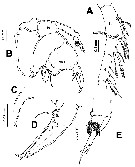 Issued from : E. Suarez-Morales & E. Kozak in ZooKeys, 2012, 234. [p.11, Fig.5]. Male: A, left A1, segments 6-8 showing spiniform process on segment 6; B, P5 showing basipod (bp) of left ramus and 1st exopodal segment of right ramus (exp1); C, right P5, detail of basal thumb of chela; D, right P5, detail of 2nd exopodal segment or distal finger of chela; E, left P5, distal segments and ornamentation.
| | | | | Ref. compl.: | | | Wilson, 1942 a (p.204); Brinton & al., 1986 (p.228, Table 1); Suarez-Morales & Gasca, 1998 a (p.111) | | | | NZ: | 1 | | |
|
Carte de distribution de Pontellopsis lubbocki par zones géographiques
|
| | | | Loc: | | | E Pacif. equatorial , Calfornian coast, Gulf of California, off W Mexico, Galapagos, off Ecuador | | | | N: | 9 | | | | Lg.: | | | (46) F: 2,9; M: 2,45; (276) F: 3,144; M: 2,84; {F: 2,90-3,14; M: 2,45-2,84}
(1119*) F: 2,09-2,17; M: 1,85-2,07. * Measured from anterior forehead to posterior border of anal somite.
| | | Dernière mise à jour : 29/01/2015 | |
|
|
 Toute utilisation de ce site pour une publication sera mentionnée avec la référence suivante : Toute utilisation de ce site pour une publication sera mentionnée avec la référence suivante :
Razouls C., Desreumaux N., Kouwenberg J. et de Bovée F., 2005-2025. - Biodiversité des Copépodes planctoniques marins (morphologie, répartition géographique et données biologiques). Sorbonne Université, CNRS. Disponible sur http://copepodes.obs-banyuls.fr [Accédé le 28 décembre 2025] © copyright 2005-2025 Sorbonne Université, CNRS
|
|
 |
 |













